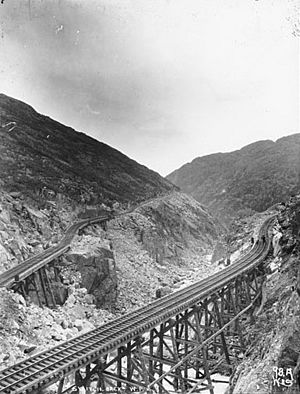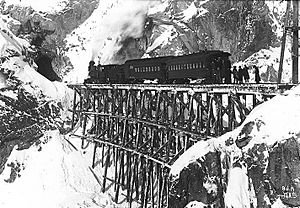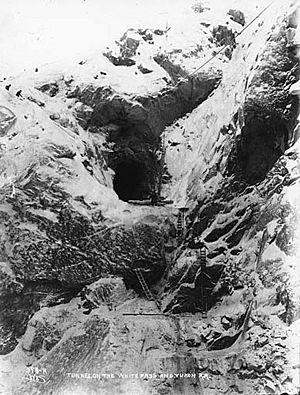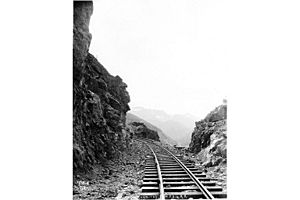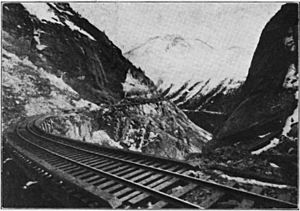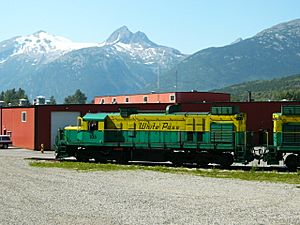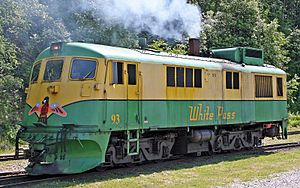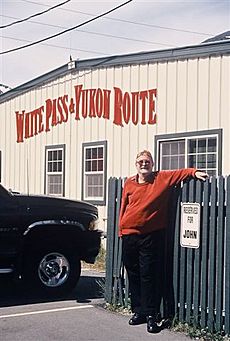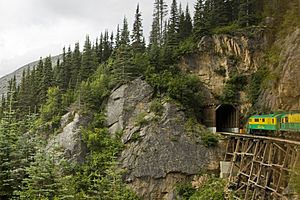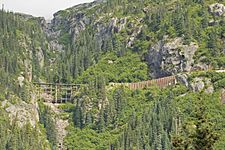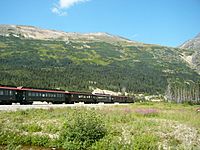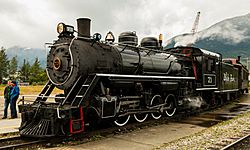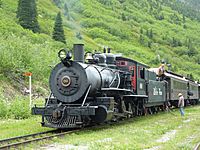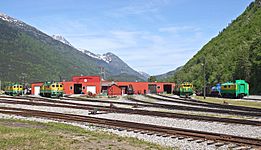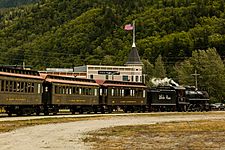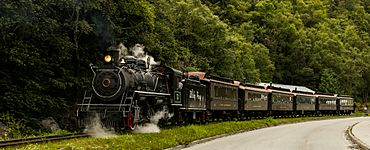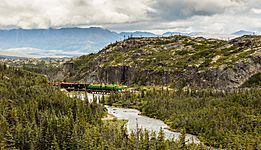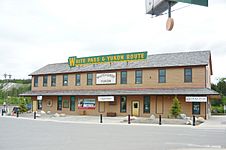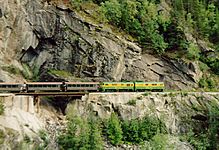White Pass and Yukon Route facts for kids
Quick facts for kids White Pass & Yukon Route |
|
|---|---|
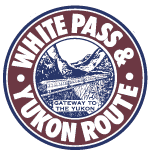 |
|
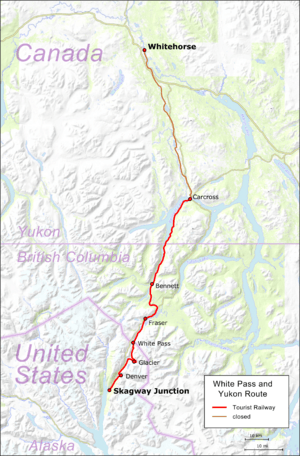 |
|
| Commercial operations | |
| Original gauge | 3 ft (914 mm) |
| Preserved operations | |
| Reporting mark | WP&YR |
| Length | 107 miles (172 km) (Skagway to Whitehorse); 67.5 miles (108.6 km) (Skagway to Carcross) |
| Preserved gauge | 3 ft (914 mm) |
| Commercial history | |
| Opened | August 1, 1900 |
| Closed | October 8, 1982 |
| Preservation history | |
| May 24, 1988 | Reopened as The White Pass Route |
| Headquarters | Skagway, Alaska |
| Website | |
| www.wpyr.com | |
The White Pass and Yukon Route (WP&YR) is a special narrow-gauge railway. It connects the port town of Skagway, Alaska, in the United States, with Whitehorse, the capital of Yukon, Canada. This railway is unique because it doesn't connect to any other train lines. Instead, its trains, cargo, and passengers arrive by ship at Skagway. They can also travel by road to some stops along the route.
Construction of the railway began in 1898 during the exciting Klondike Gold Rush. It was built to help people reach the goldfields more easily. When it was finished in 1900, it became the main way to travel into the Yukon. It replaced tough routes like the Chilkoot Trail. The railway ran until 1982. Then, in 1988, it partly reopened as a heritage railway, mainly for tourists. In 2018, the railway was bought by a company called Carnival Corporation & plc.
The White Pass and Yukon Route is considered an important historical engineering landmark. Both the Canadian Society for Civil Engineering and the American Society of Civil Engineers gave it this special title in 1994.
Contents
How the White Pass Railway Was Built
Building the Tracks for Gold
The railway was created because of the Klondike Gold Rush in 1897. Many gold seekers, called prospectors, traveled to Dawson City. Their journey started from Skagway or Dyea, Alaska. They had to cross mountains to reach the Canada–US border at the top of the Chilkoot Pass or the White Pass.
Canadian rules said prospectors needed a lot of supplies to cross the border. This was usually about one ton of gear for the winter. This meant they had to make several trips across the difficult passes. People needed a better way to move supplies than using pack horses or carrying everything themselves. This led to many ideas for building a railway.
Choosing the Right Design
In 1897, three different companies planned to build a railway from Skagway to Fort Selkirk, about 325 miles (523 km) away. British investors helped pay for the project. The railway's builder, Michael James Heney, chose a 3 ft (914 mm) narrow gauge. This meant the tracks were closer together.
A narrow track bed was cheaper to build, especially when blasting through solid rock. They used 450 tons of explosives to reach the White Pass summit. Narrow gauge also allowed for tighter curves. This made it easier for the railway to follow the natural shape of the land.
Overcoming Challenges in Skagway
Construction began in May 1898. However, the builders faced problems with the Skagway city government and a local leader named Soapy Smith. The railway's president, Samuel H. Graves, became a leader in a group trying to remove Soapy Smith and his gang.
On July 8, 1898, Soapy Smith was killed during a meeting. Samuel Graves saw the event. The railway helped block escape routes for the gang, leading to their capture. After this, the problems in Skagway became much smaller.
Reaching the Summit and Beyond
On July 21, 1898, the first train in Alaska carried passengers for 4 miles (6.4 km) out of Skagway. On July 30, 1898, a new company, the White Pass & Yukon Railway Company Limited, took over the project. By mid-February 1899, the railway reached the 2,885-foot (879.3 m) summit of White Pass, 20 miles (32 km) from Skagway.
The railway reached Bennett, British Columbia, on July 6, 1899. In the summer of 1899, construction started north from Carcross toward Whitehorse. This was 110 miles (177 km) north of Skagway. The crews working from Bennett reached Carcross the next year. The last spike was driven on July 29, 1900. Regular train service began on August 1, 1900. By this time, much of the Gold Rush excitement had slowed down.
The "gold spike" driven was actually a regular iron spike. A real gold spike was ready, but gold is too soft. It would have been flattened instead of driven into the ground.
Life of the Railway: Early Years to Closure
Moving Beyond Gold Mining
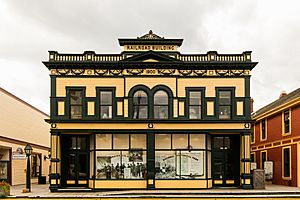
As the gold rush ended, serious mining for other metals began. These included copper, silver, and lead. Skagway was the closest port for these mines. The only way to get there was by the White Pass & Yukon Route's river boats and railway.
The railway mainly carried ores and metal concentrates. But it also transported passengers and other goods. For a long time, it was the only easy way to get into the Yukon Territory. It was also the only way to get into or out of Skagway, except by sea.
The railway had plans to extend its tracks from Whitehorse to Carmacks. However, there were problems with river transportation. So, White Pass used its money to buy most of the riverboats. This created a steady and reliable transport system between Whitehorse and Dawson City.
Small Expansions and Challenges
The WP&YR never built tracks between Whitehorse and Fort Selkirk. But it did make some small expansions after 1900. In 1901, the Taku Tram was built. This was a 2+1⁄2-mile (4 km) short railway that carried passengers and goods. It operated until 1951.
In 1910, the WP&YR ran a branch line to Pueblo, a mining area near Whitehorse. This branch line was closed in 1918. Today, a road follows that path.
By June 1914, the WP&YR had 11 locomotives and many passenger and freight cars. It was still making a profit. While other railways in the Yukon closed by 1914, the WP&YR kept running. During the Great Depression, traffic was low. Sometimes, trains ran only once a week.
The Railway During World War II
World War II made Alaska very important for the United States. There was worry that Japan might attack it. So, the US and Canadian governments decided to build the Alaska Highway. This road would provide a way to communicate and move supplies year-round. Whitehorse was a key starting point for building this highway. The WP&YR supplied Whitehorse.
Before the war, the railway was struggling financially. Its engines and cars were old. But in the first nine months of 1942, it moved more than double its usual yearly traffic. This still wasn't enough. So, the U.S. Government leased the railway in October 1942. The United States Army took control.
The Army brought in many different narrow-gauge locomotives and cars. These included seven large 2-8-2 engines and other older ones. The WP&YR originally had 10 locomotives and 83 cars. The Army added 26 engines and 258 cars.
Traffic increased greatly. In 1943, the line carried 281,962 tons. This was like ten years of normal traffic! This happened despite very bad winter weather. The railway was blocked by gales and snowdrifts in 1943 and 1944. On August 4, 1943, the White Pass ran 38 trains in 24 hours. Control of the railway was given back to its civilian operators in late 1944.
Modernizing and Closing (1946–1982)
In 1951, a new company was formed to own the railway. The railway was financially reorganized. While most other narrow-gauge railways in North America were closing, the WP&YR stayed open. In 1959, it paid its first dividend to stockholders.
The railway started using diesel locomotives in the mid-1950s. It was one of the few narrow-gauge railways in North America to do so. The last steam locomotive was retired on June 30, 1964.
The railway was also a leader in using containers to move goods. They called it the Container Route. The WP&YR owned an early container ship. In 1956, it started using containers.
In 1969, the Faro lead-zinc mine opened. The railway was upgraded with new locomotives, freight cars, and an ore dock. A new tunnel and bridge were built to handle heavier trains. This big investment meant the railway depended heavily on carrying ore.
Passenger traffic also grew as cruise ships began visiting Alaska. There was no road from Skagway to Whitehorse until 1978. Even after the road was built, the White Pass still relied on the ore from the mines.
In 1982, metal prices dropped sharply. This badly affected the mines that were the railway's main customers. Many mines, including the Faro mine, closed. Without this traffic, the White Pass could not continue as a commercial railway. It ran at a loss for several months, carrying only passengers. But on October 7, 1982, the railway closed down.
Some of the railway's diesel engines were sold to other companies. The railway was featured in a BBC Television series called Great Little Railways in 1983.
The White Pass as a Heritage Railway (1988–Present)
The railway's shutdown didn't last long. Tourism to Alaska began to grow, with many cruise ships stopping at Skagway. The beautiful scenery of the White Pass route seemed like a great attraction for tourists. The railway tracks went right down to the docks, perfect for cruise ship passengers. Cruise operators wanted the railway to reopen for tourists.
After an agreement was made, the White Pass Route reopened in 1988. It ran between Skagway and White Pass only for tourist passengers. The railway also tried to get the contract to haul ore from the reopened Faro mine. But its price was higher than using trucks on the road.
The railway still uses old-fashioned parlor cars. The oldest four were built in 1881, even before the WP&YR existed. Four new cars built in 2007 look just like the old 19th-century designs. Some cars even have lifts for wheelchairs.
In September 1988, a work train reached Whitehorse. Its goal was to bring two locomotives, which had been parked in Whitehorse for six years, back to Skagway for repairs. Most of the tracks in downtown Whitehorse have now been removed. The railway's end point is now south of the old train station.
After some legal issues were fixed, the WP&YR main line reopened to Fraser in 1989 and Bennett in 1992. A train reached Carcross in 1997 for a special celebration. A special passenger trip was made from Carcross to Whitehorse in October 1997. There are plans to eventually reopen the entire line to Whitehorse if enough people want to use it.
Today, the tracks are certified for use up to Carcross. In July 2006, White Pass announced regular passenger service to Carcross would begin in May 2007. This means about 63% of the original line is now used again. The WP&YR is longer than other famous narrow-gauge railways in North America.
The WP&YR also bought some rolling stock (train cars) from the Canadian National Railway after its Newfoundland operations closed. These cars were changed to fit the White Pass and Yukon Route's narrow gauge tracks.
Most trains are pulled by the railway's diesel locomotives, which are green and yellow. But one of the steam locomotives, No. 73, a 2-8-2 Mikado-type, is still running. Another steam locomotive, No. 69, was bought back in 2001 and put back into service in 2008.
An original steam-powered rotary snowplow is also used a few times a year. This machine was very important when the railway carried goods. While it's not needed for summer tourist season, it's a great sight to see. The White Pass runs the steam plow for train fans in the winter.
The 100th anniversary of the "Golden Spike" at Carcross was celebrated on July 29, 2000. Two steam engines met nose-to-nose, and a gold-coated steel spike was driven.
In June 2005, a special steam-pulled train went from Carcross to Fraser. This was the first time paid passengers traveled out of Carcross since 1982. This service became regular in 2007.
The White Pass president, Gary Danielsen, said that reopening service to Whitehorse would cost a lot of money. But the company is willing to do it if there's enough demand for passengers or freight.
In June 2010, the railway and the City of Skagway agreed to work together. They want to bring back freight service on the line. This includes rebuilding the tracks north of Carcross to Whitehorse. There's also a possibility of building new tracks north from Whitehorse to Carmacks. This expansion would help the region's mining industry.
Some former White Pass steam locomotives are now used at tourist attractions in the Southeastern United States. Locomotives 70, 71, and 192 are at the Dollywood amusement park in Pigeon Forge, Tennessee. Locomotive 190 is at the Tweetsie Railroad in Boone, North Carolina.
White Pass Locomotives and Cars
For a detailed list of White Pass locomotives and railroad cars, you can look at the List of White Pass and Yukon Route locomotives and cars.
For a list of White Pass boats, see List of steamboats on the Yukon River.
For a list of White Pass winter stages, see Overland Trail (Yukon).
Army Locomotives in World War II
There are two common stories about the eleven new USATC S118 Class locomotives the United States Army Transportation Corps brought to the WP&YR in 1943. The first story says they were changed from a different track width to 3 ft (914 mm) gauge at the WP&YR shops in Skagway. The second story says they were built for Iran but sent to the WP&YR instead.
These locomotives, numbered USA 190 to USA 200, were actually built by Baldwin Locomotive Works as 3 ft (914 mm) gauge. They were shipped fully assembled and didn't need any changes. The design allowed for different track widths by using spacers between the wheels.
The story about Iran is also incorrect. Iran's railway uses a different track width. Also, the Army mainly used diesel locomotives in Iran because of water shortages and many tunnels. So, these narrow-gauge locomotives were never meant for Iran.
The first locomotives of this design that Baldwin Locomotive Works built were USA 190–200 for the WP&YR. This makes them special. The original order for 60 locomotives was for India's railway system. The first eleven were sent to the WP&YR. Then, 15 went to India, 20 went to Queensland Rail in Australia, and the remaining 14 went to India as planned.
Images for kids
-
Parlor cars seen at Fraser, BC.


